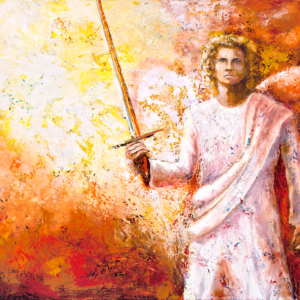Sayward Wheeler, the central character of Conrad Richter’s trilogy The Awakening Land, has been illiterate all her life. The trilogy is set in the late eighteenth to early nineteenth century Ohio Valley wilderness, where Sayward’s father had brought the family from Pennsylvania when she was young. The girls weren’t taught to write or read, nor were many of the boys.
In The Fields, the trilogy’s second volume, Sayward is married and has eight children. The oldest, Resolve, has started going to the settlement’s new school and has just taught his mother to write the alphabet. At the end of Chapter 11, she has traced on her slate “some fourteen letters chained for the most part together.”
"Can you read it, Resolve?" she asked him anxiously. "Oh, I can read it good," he told her, pleased, trying to talk like his teacher. "What does it say?" "It says your name, Sayward Wheeler." "You knowed!" she protested. "Could your pappy read it, do you think?" "Anybody could," Resolved told her. His mam's face grew almost cruel with hidden feeling. She held the slate straight out in her hand and gazed unwinkingly at the letters. "That writing stands for me!" she said. "I can't get over it." There was a power of pride and wonder in her voice.
Reading this, I was struck by Sayward’s “power of pride and wonder.” Small children must feel this when they first learn to write their names. But we adults in the so-called “civilized world” take writing for granted. When I sign my name to a check, I certainly don’t feel pride and wonder. What I wonder is whether I have money in the bank to cover the amount.
This passage got me wondering, too, about how writing first came to be. So I pulled from my bookshelf Alberto Manguel’s extraordinarily rich A History of Reading. It focuses, yes, on reading. But you can’t have reading without writing—because, of course, someone has to have written what you read.
Manguel has less on writing per se than I’d expected. But there is a brief history of writing in his chapter called “Beginnings.” Here are some of the tidbits:
- The very first writing was in Mesopotamia in the fourth millennium BC, probably to aid in commerce: to keep track of who sold a cow or ox to whom. It was pictographic; what was “written” was an image of the cow or ox.
- Clay tablets were invented for this purpose. And so, for the first time in history, as if “magically,” Manguel says, a message “could be acquired without the physical presence of the message-giver.” That is, the invention of writing was at the same time the invention of the reader.
- The Mesopotamian scribe was highly valued because of his irreplaceable skill. And here Manguel displays the delightfully voluminous detail for which his book is celebrated:
“Scribes were needed to send messages, to convey news, to take down the king’s orders, to register the laws, to note the astronomical data necessary for keeping the calendar, to calculate the requisite number of soldiers or workers or supplies or head of cattle, to keep track of financial and economic transactions, to record medical diagnoses and prescriptions, to accompany military expeditions and write dispatches and chronicles of war, to assess taxes, to draw contracts, to preserve the sacred religious texts and to entertain the people with readings from the epic of Gilgamesh.”
- A radical change in writing took place by the second millennium BC: Mesopotamian writing changed from pictographic to “cuneiform”: “signs representing sounds, not objects.” We don’t know how this development came about, but it’s impossible to overstate its significance. Now anything could be put in writing.
Manguel’s terms—especially his observation that writer and reader were created simultaneously—reminded me of Roland Barthes’ books on the subject, which I had read when they came out in the 1970s (in the heyday of structuralism). So back to my bookshelves I went, pulling out S/Z and The Pleasure of the Text.
S/Z, Barthes’ notorious “cutting into” a Balzac short story to display all the semiotic “codes” that run through it, enacts Barthes’ thesis that writing is never about anything except, well, writing. For instance, narrators and characters don’t have qualities (like reliable or unreliable, coy or self-conscious); rather, they’re comprised of language. “When identical semes traverse the same proper name several times and appear to settle upon it, a character is created.” Similarly, the discourse, which we’re used to thinking of as the medium through which an author speaks to readers, is not for Barthes a medium but rather the very stuff of writing: “the discourse, and not one or another of its characters, is the only positive hero of the story.”
“Writing is active,” Barthes insists, “for it acts for the reader.” (Acts, play-acts, performs….) This could be taken as S/Z‘s summary statement, which Barthes develops extensively (even outrageously) in The Pleasure of the Text. I say “outrageously” because in this book, published three years after S/Z, Barthes lays out an erotics of writing and reading. Here writing not only acts for the reader; it pursues the reader, “cruises” him. “The text you write must prove to me that it desires me.”
Throughout the book, Barthes rings changes on the text’s “pleasure” and “bliss.” “The text of pleasure is not necessarily the text that recounts pleasures; the text of bliss is never the text that recounts the kind of bliss afforded literally by an ejaculation.” “The brio of the text (without which, after all, there is no text) is its will to bliss.”
This is all a bit over the top, you’re probably thinking; and I agree. So would Barthes: there’s nowhere he wanted to perch more than “over the top.”
Yet Barthes showed us, as no one had before, how a text splits open to draw the reader into it and through it. His “close reading” was so close that it penetrated and fissured the text.
But to return to Sayward Wheeler’s excitement at writing her name: “That writing stands for me!” Barthes would disagree, since for him writing stands only for itself.
I’m inclined to see it as Sayward does. Texts do interweave and interrelate. But they don’t comprise a self-enclosed world. They stand for something outside themselves: recall Alberto Manguel noting that writing was invented to record how many cows someone bought.
Without cows, no writing. That writing stands for cows, or for a character’s feelings, or for me.
Peggy Rosenthal has a PhD in English Literature. Her first published book was Words and Values, a close reading of popular language. Since then she has published widely on the spirituality of poetry, in periodicals such as America, The Christian Century, and Image, and in books that can be found here.





